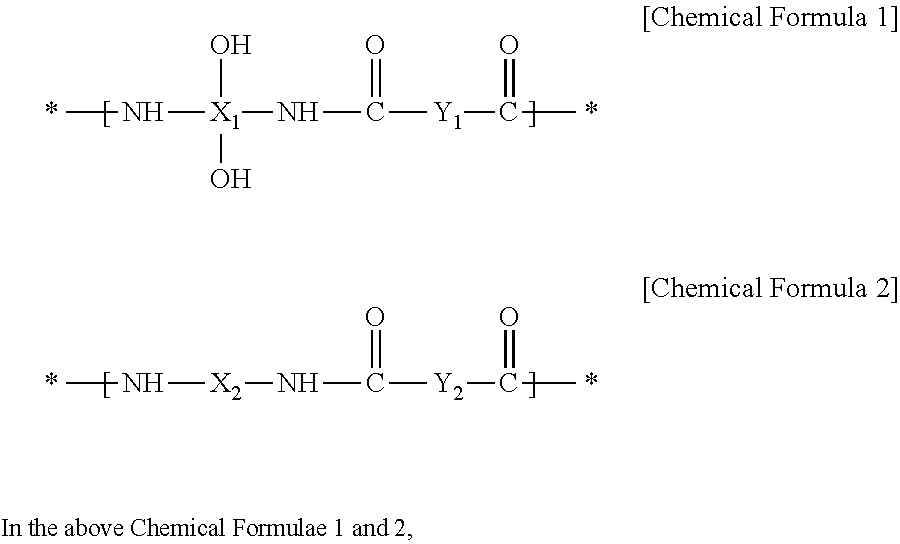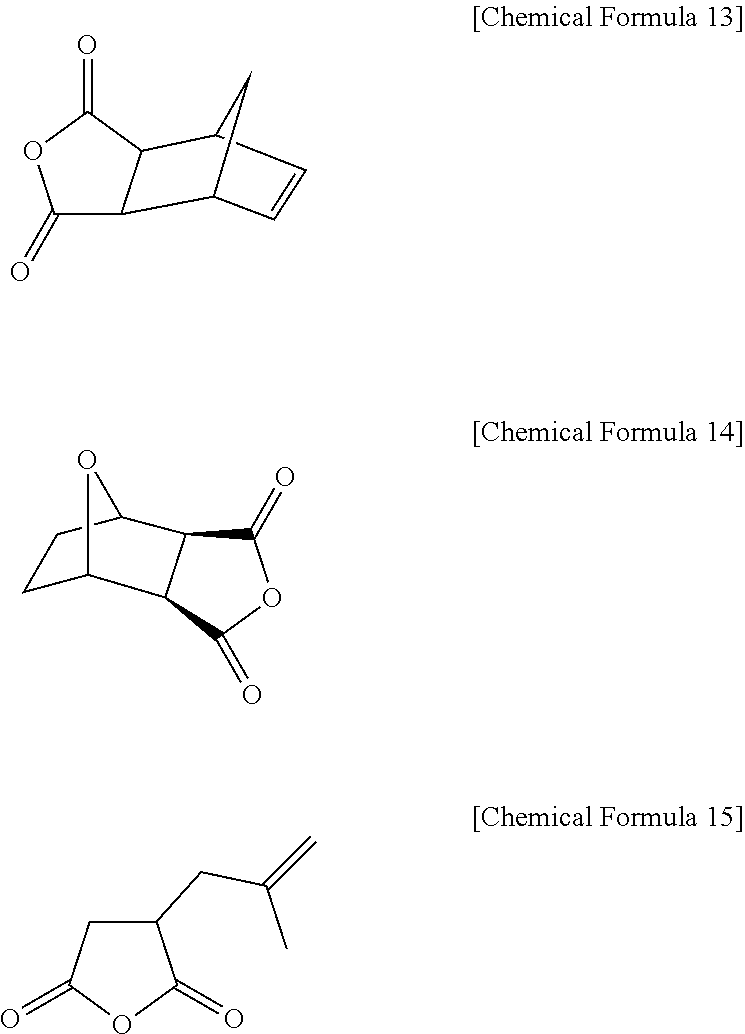Positive Photosensitive Resin Composition
a technology of resin composition and photosensitive resin, which is applied in the direction of photosensitive materials, photomechanical equipment, instruments, etc., can solve the problems of insufficient development, inability to obtain desired patterns, and insufficient development of polyimide precursor compositions, so as to improve mechanical properties and reliability of films, improve the molecular weight of polymers before curing processes, and improve the effect of developmen
- Summary
- Abstract
- Description
- Claims
- Application Information
AI Technical Summary
Benefits of technology
Problems solved by technology
Method used
Image
Examples
synthesis example 1
Synthesizing Phenol Compound (P-1)
[0219]
[0220]50 g of 3,4,5-trihydroxy benzoic acid (1), 150 g of acetic anhydride, and 34.8 g of sodium hydroxide (NaOH) are reacted in a four-necked flask mounted with an agitator, a temperature controlling device, a nitrogen gas injector, and a condenser, while nitrogen is passed therethrough to synthesize 3,4,5-triacetoxy benzoic acid (2). Acetic anhydride is removed under vacuum conditions, and then 60 g of thionyl chloride (SOCl2) and 5 g of dimethyl formamide (DMF) are added while performing extraction using chloroform to synthesize triacetoxybenzoyl chloride (3).
[0221]20 g of 4-aminophenol (4) and 33 g of 5-norbornene-2,3-dicarboxyl anhydride are added to 250 ml of a tetrahydrofuran (THF) solvent including 15.8 g of pyridine in a four-necked flask mounted with an agitator, a temperature controlling device, a nitrogen gas injector, and a condenser while nitrogen is flowing, and then agitation is performed at room temperature for 4 days. After t...
synthesis example 2
Synthesizing Phenol Compound (P-2)
[0224]A phenol compound (P-2) is synthesized according to the same method as in Synthesis Example 1 except that maleic anhydride is used instead of 5-norbornene-2,3-dicarboxylic anhydride.
synthesis example 3
Synthesizing Phenol Compound (P-3)
[0225]
[0226]35.5 g of benzyl bromide, 10.0 g of 3,5-dihydroxybenzoic acid (8), and 20.0 g of potassium carbonate (K2CO3) are added to 250 ml of acetone and refluxed for 24 hours in a four-necked flask mounted with an agitator, a temperature controlling device, a nitrogen gas injector, and a condenser, while nitrogen is passed therethrough. After it is cooled and vacuum-dried, 100 ml of ethanol, 30 ml of distilled water, and 20.0 g of potassium hydroxide are added. Next, it is refluxed for 24 hours, and 400 ml of water is added. Then, glacial acetic acid and dichloromethane are added, and extracted, and a solvent is removed under a vacuum condition to provide the compound (9). 4.60 g of the compound (9) is dissolved in a tetrahydrofuran (THF) solvent, and then 1.55 g of nitrophenol is added therein, and then it is put into dicyclohexyl carbodiimide (DCC) and 4-dimethylaminopyridine (DMAP). Agitation is performed at room temperature for 6 hours, and a...
PUM
| Property | Measurement | Unit |
|---|---|---|
| temperature | aaaaa | aaaaa |
| temperature | aaaaa | aaaaa |
| temperature | aaaaa | aaaaa |
Abstract
Description
Claims
Application Information
 Login to View More
Login to View More - R&D
- Intellectual Property
- Life Sciences
- Materials
- Tech Scout
- Unparalleled Data Quality
- Higher Quality Content
- 60% Fewer Hallucinations
Browse by: Latest US Patents, China's latest patents, Technical Efficacy Thesaurus, Application Domain, Technology Topic, Popular Technical Reports.
© 2025 PatSnap. All rights reserved.Legal|Privacy policy|Modern Slavery Act Transparency Statement|Sitemap|About US| Contact US: help@patsnap.com



